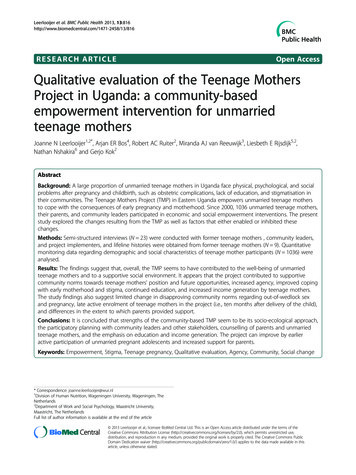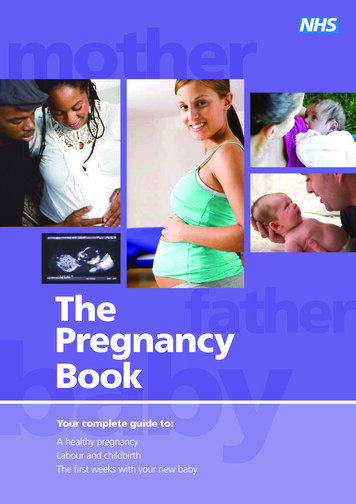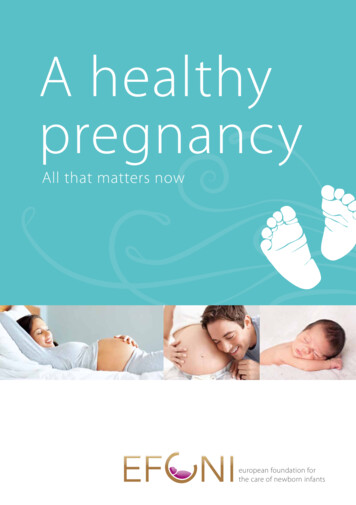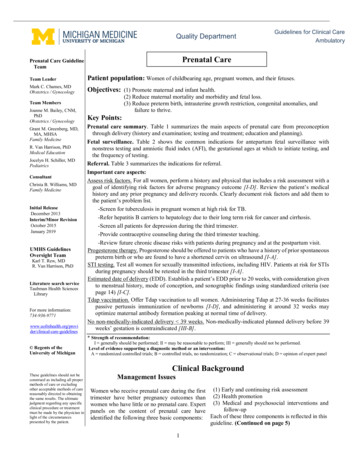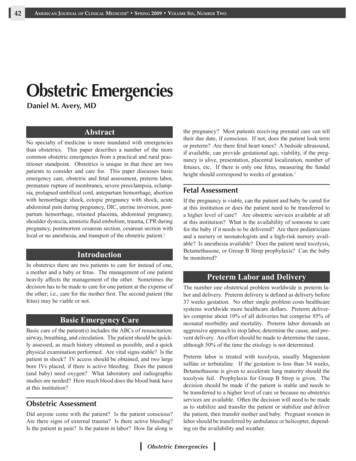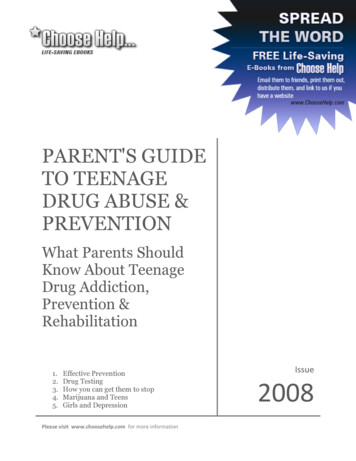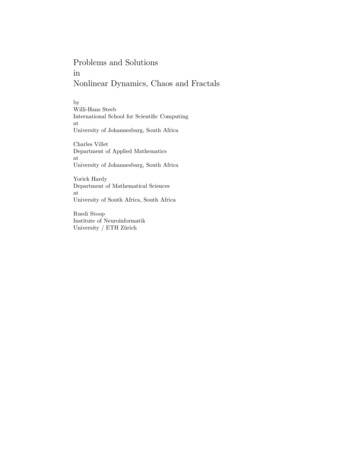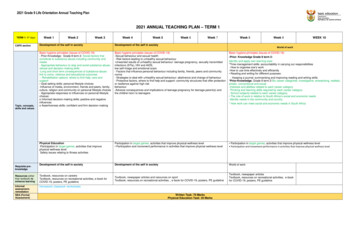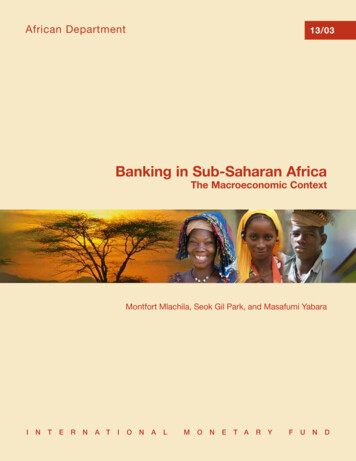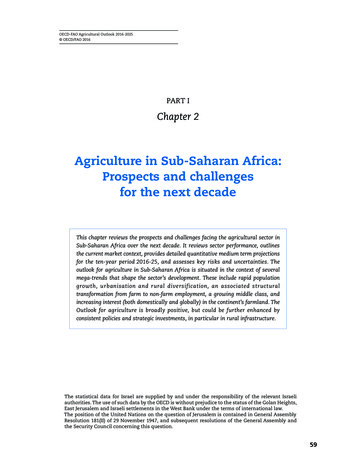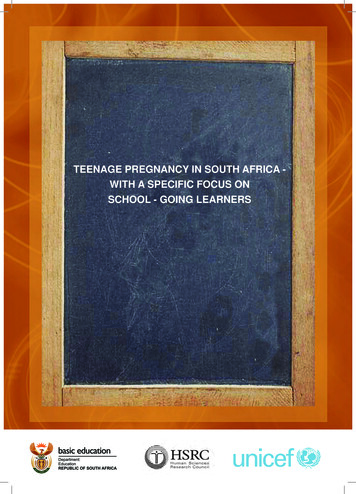
Transcription
TEENAGE PREGNANCY IN SOUTH AFRICA WITH A SPECIFIC FOCUS ONSCHOOL - GOING LEARNERS
Produced by the Human Sciences Research Council on behalf ofthe Department of Basic Education, with support from UNICEF.Suggested citation:Panday, S., Makiwane, M., Ranchod, C., & Letsoalo, T. (2009). Teenage pregnancy in South Africa- with a specific focus on school-going learners. Child, Youth, Family and Social Development, HumanSciences Research Council. Pretoria: Department of Basic Education.August 2009ISBN No.: 978-0-620-44701-0
Department of Basic EducationPrivate Bag X895, Pretoria, 0001,Tel: 012 312 5911, Fax: 012 312 5218www.education.gov.zaToll Free: 0800 202 933ISBN: 978-0-620-44701-0
Teenage pregnancy in South Africa - with a specific focus on school-going learnersTeenage pregnancy in South Africa with a specific focus on school-going learners1
Teenage pregnancy in South Africa - with a specific focus on school-going learners2
Teenage pregnancy in South Africa - with a specific focus on school-going learnersFOREWORD BY MINISTER: BASIC EDUCATIONSouth Africa has made significant progress since 1994 towards achieving gender parityin basic education. In fact, we have gone beyond achieving gender parity, to the extentthat girls now make up the majority of enrolments in secondary schools. However,pregnancy is amongst the major concerns that pose a serious threat to gains achievedin public schools thus far. Teenage pregnancy undermines the Department’s efforts toensure that girl children remain in school, in order to contribute towards a quality life forall, free of poverty.The Department of Basic Education has taken an active role in seeking to understand and effectively addressthis challenge, as it impacts significantly on learners. In 2008, the Department commissioned a desktop study todocument, review and critically analyze literature on teenage pregnancy with a focus on school-going adolescents.The study analyzes both the prevalence of teenage pregnancy and its determinants. It is my privilege to present thereport of this study ‘Teenage Pregnancy in South Africa, with a Specific Focus on School–Going Learners’.Findings from this study are that teenage fertility in South Africa has been declining over time. Declines in overall fertilityrates have been attributed to, amongst others, increased access to information on reproductive health and rights andimproved contraceptive use. The study has further identified that learner pregnancies are more concentrated in theprovinces of Eastern Cape, Limpopo and KwaZulu Natal; thereby necessitating targeted interventions in these areas.In addition, the study states that learner pregnancies are higher in schools located in poorer neighbourhoods.Despite the reported decline in teenage fertility rates, the high proportion of unintended pregnancies for teenagers inSouth Africa remains a serious problem. Pregnant teenagers face serious health, socio-economic and educationalchallenges. One teenage learner pregnant is one too many, and the Department therefore does not take comfortin the reported decline of teenage fertility, but seeks to strengthen efforts towards addressing this challenge. Tothis end, the Department will develop a comprehensive strategy towards addressing learner pregnancy in SouthAfrica, outlining definitive interventions for implementation through the schooling system. The report also notes thatremaining in the education system is a strong factor in preventing teenagers from falling pregnant, and we musttherefore continue to work to keep young women in school.However, we are mindful of the fact that addressing teenage pregnancy is not a challenge facing only one department.Addressing teenage pregnancy is a battle that requires the active involvement of all stakeholders, if it is to be wellfought. These stakeholders include other government departments, key organisations in the non-governmentalsector; the research community, the religious sector, community leaders and more importantly, parents and thelearners themselves. It is for this reason that we invite all stakeholders to study the report, and draw from it that whichcan assist them to respond better to the challenges in their respective sectors.Thank you to the HSRC researchers who worked on this report. I also offer my sincere thanks to our partner UNICEF,who provided the funding that made the study possible.Mrs AM MotshekgaMinister of Basic EducationAugust 20093
Teenage pregnancy in South Africa - with a specific focus on school-going learners4
Teenage pregnancy in South Africa - with a specific focus on school-going learnersTable of ContentsExecutive Summary. 9Introduction. 20Methods. 23Terms of reference. 23Aims . 23Objectives. 23Approach to the study. 23Literature review. 23Secondary data analysis. 25Definitions. 26Trends in Teenage Fertility. 27Literature review. 27International. 27National. 28Fertility history in South Africa. 28Teenage fertility in relation to overall fertility. 30Case A: Trends in fertility in the Eastern Cape. 31Case B: South African fertility trends, 1980-2001. 32Lessons from analysis of trends in fertility. 33Differentials. 34Age. 35Location. 36Population group. 37Education. 38Secondary analysis. 40EMIS data. 40Provincial data. 44Abortion. 45Barriers to legal abortion. 45Consequences of Early Childbearing. 47Health consequences. 47Educational and economic consequences. 49Social consequences. 50Determinants. 52Conceptual framework. 52Literature review. 53Intrapersonal factors. 54Sexual behaviour. 54Sexual experience. 54Sexual partnerships. 54Sexual frequency. 55Age mixing. 55Contraceptive use. 555
Teenage pregnancy in South Africa - with a specific focus on school-going learnersKnowledge, beliefs and attitudes about contraception. 56Attitudes towards teenage pregnancy. 58Risk perception. 59Substance use. 61Childhood sexual and physical abuse. 61Interpersonal factors. 62Families. 62Family type. 62Parental values and role-modelling. 63Parental style, monitoring and support. 64Parental communication. 64Partners. 65Peers . 66Communities. 67Institutional factors. 68Structural factors. 69Cultural context. 69Socio-economic status and poverty. 71Public policy. 72Secondary analysis. 73Profile of male partners. 74Who are young fathers?. 75Attitudes towards early fatherhood. 77Barriers to teen fatherhood. 77Policy and Programmes. 80Prevention programmes. 81School-based sex education. 81School based/linked health services. 85Parenting. 85Peer programmes. 85Sexual and reproductive health services. 87Access to family planning services. 88Adolescent friendly services. 89Termination of pregnancy services. 90Mass media campaigns. 90Community-based interventions. 96Youth development programmes. 98Second chance programmes. 99Flexible school policies. 99What works best for second chance programmes. 101Child support grant. 103Conclusions and Recommendations. 105Fertility. 105Abortion. 106Determinants. 1066
Teenage pregnancy in South Africa - with a specific focus on school-going learnersRole of education. 107Young fathers. 107Interventions. 108Recommendations. 109Prevention. 109Sexual risk factors. 109Universal implementation of sex education. 109Targeted interventions for high risk groups. 110Non-sexual risk factors. 110Interventions to retain girls in school. 110Service learning.111Second chances.111Other sectors. 112Communities. 112Health. 112Parents. 113Mass media. 113Scope and coverage of research. 113Fertility. 113EMIS data. 113Determinants. 114Interventions. 115References. 116Appendices. 140Appendix 1: Literature search strategy. 140Appendix 2: The HSRC 2003 Status of the Youth Survey – Methods. 1417
Teenage pregnancy in South Africa - with a specific focus on school-going learnersList of TablesTable 1:Fertility trends in Transkei by marital status and age, 1980-1994.31Table 2:Teenage fertility rates (per 1000 women) by population group, 1996-2001.33Table 3:Adolescent pregnancy and motherhood, South Africa, 1998.34Table 4:Learner pregnancy rates, 2004-2008.41Table 5:Learner pregnancy rates per province, 2004-2008.41Table 6:Selected variables and the proportion of missing data.42Table 7:Distribution of learner pregnancy by institutional phase.42Table 8:Distribution of learner pregnancy by level of specialisation.43Table 9:Distribution of learner pregnancy by school fees.43Table 10: Distribution of learner pregnancy by school land ownership.43Table 11: Consequences of early childbearing.47Table 12: An ecological perspective: levels of influence.53Table 13: Selected social factors related to early pregnancy among women in SA, 2003.74Table 14: Selected social factors related to early pregnancy among young men in SA, 2003.76Table 15: Factors affecting young father’s wellbeing and participation in parenting.78Table 16: Characteristics of effective curriculum-based programmes.81Table 17: Sources of information related to HIV and AIDS for young people in SA.92Table 18: Cumulative odds of behaviour change with increased exposure to communication campaigns.96List of FiguresFigure 1: Births to women aged 15-19 per thousand women, 1990, 2000 and 2005.28Figure 2: Overall fertility trends in South Africa.29Figure 3: Trends in teenage fertility, 1980-2007.32Figure 4: Trends in teenage fertility-Africa Centre Demographic Surveillance System, 1990-2005.33Figure 5: Pregnancy among 15-19 year olds by age, 2003.35Figure 6: Percentage of women aged 15-19 who are mothers per province, 1998.36Figure 7: HIV prevalence by geography type among 15-24 year olds in South Africa, 2003.37Figure 8: Teenage fertility by population group, 1996-2001.37Figure 9: Increasing teenage pregnancy rates among those who are not at school.39Figure 10: Reasons for teenage pregnancy among young women who have ever been pregnant.56Figure 11: Perception of the most important issues facing youth in South Africa, 2003.60Figure 12: Perception of risk for unplanned pregnancy, STIs, HIV and sexual assault, 2003.60Figure 13: Proportion of 15-24 year olds who know of Soul City, loveLife and Khomanani.95List of BoxesBox 1:Description of three national HIV and AIDS campaigns in SA.938
Teenage pregnancy in South Africa - with a specific focus on school-going learnersExecutive SummaryThe transition to parenthood is a major event in the lifespan of any individual, but takes on special significancewhen it precedes the transition to education, work, citizenship and marriage that offer the skills, resources andsocial stock necessary to succeed as parents. Although alternative pathways to parenthood occur and aretolerated to some extent, institutional support for parenthood is still geared towards a traditional sequencingof transitions.HIV/AIDS is now recognised as the primary reproductive health concern for adolescents, overtaking the longstanding emphasis on adolescent fertility. Yet childbearing among teenagers remains a common social andpublic health concern worldwide, affecting nearly every society. Teenage fertility, establishes the pace andlevel of fertility over a woman’s entire reproductive life span. This has an impact not only on women’s health,but on the socio-economic status and general wellbeing of the population. Despite public health literature andfamily planning services treating HIV and pregnancy as distinct, they share many common antecedents chiefamongst which is unprotected sex. What is more, there is evidence that pregnancy and lactation increase thesusceptibility to HIV infection through immunological changes induced during pregnancy.Even though teenage fertility has been the subject of substantial debate in the social science research andpolicy circles, concern has not emanated from the increased risk that pregnancy confers to HIV. While currentpolitical and media depictions imply that SA is confronted with an escalating epidemic of teenage pregnancies,available data suggests that it is an area in which substantial progress has been made since democracy. Yetteenage pregnancy has grown in significance as a social construct and come to represent one of severalindicators of burgeoning adolescent delinquency, sexual permissiveness and moral decay.Education is central to the development of young people as it prepares them for the world of work and forlife. As young people spend longer periods in education, as part of the natural course of development, sexualexperimentation and maturity is increasingly coinciding with secondary schooling. For most, it remains at thelevel of experimentation and if sex occurs, indications are that it is more likely to be protected when youngpeople are still at school. However, for a minority, it results in unwanted pregnancy, HIV and other sexuallytransmitted infections. This has implications for continued educational opportunities.In a rights-based society, young girls who fall pregnant should not be denied access to education and this isentrenched in law in SA through the Constitution and Schools Act of 1996. In 2007, the Department of Educationreleased Measures for the Prevention and Management of Learner Pregnancy. Not without controversy, theguidelines continue to advocate for the right of pregnant girls to remain in school, but suggests up to a twoyear waiting period before girls can return to school in the interest of the rights of the child. Any proposedshift in policy and practice needs to be informed by a well-rounded understanding of the context of teenagepregnancy.9
Teenage pregnancy in South Africa - with a specific f
Teenage pregnancy in South Africa - with a specific focus on school-going learners Executive Summary The transition to parenthood is a major event in the lifespan of any individual, but takes on special significance when it precedes the transition to education, work, citizenship and
